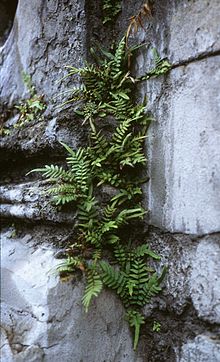Pteris
| Pteris | |
|---|---|
 |
|
| Pteris vittata | |
| Scientific classification | |
| Kingdom: | Plantae |
| Division: | Pteridophyta |
| Class: | Pteridopsida |
| Order: | Polypodiales |
| Family: | Pteridaceae |
| Subfamily: | Pteridoideae |
| Genus: |
Pteris L. |
| species | |
|
See text |
|
See text
Pteris (brake) is a genus of about 280 species of ferns in the Pteridoideae subfamily of the Pteridaceae. They are native to tropical and subtropical regions of the world.
Many of them have linear frond segments, and some have sub-palmate division. Like other members of the Pteridaceae, the frond margin is reflexed over the marginal sori. The outermost layer is the single layered epidermis with out stomata.The cortex is differentiated into outer and inner cortical region . The vascular cylinder is amphiphloic siphonostele
The term "brake", used for members of this genus, is a Middle English word for "fern" from southern England. Its derivation is unclear, and is generally thought to be related to "bracken", whereby the latter word has been assumed to be a plural, as with "children", and the former word a back-formation. However it may have a separate derivation.
Some of these ferns are popular in cultivation as houseplants. These smaller species are often called "table ferns".
Pteris vittata (commonly known as brake fern) was discovered to have the ability to "hyperaccumulate" (absorb large amounts of) arsenic from soil. The fern was growing at a central Florida site contaminated with large amounts of copper arsenate in the soil. Dr. Lena Q. Ma of the University of Florida later discovered that it had hyperaccumulated considerable amounts of arsenic from the soil. The discovery may lead to the use of Pteris vittata as a potential bioremediation plant. [1]
...
Wikipedia
